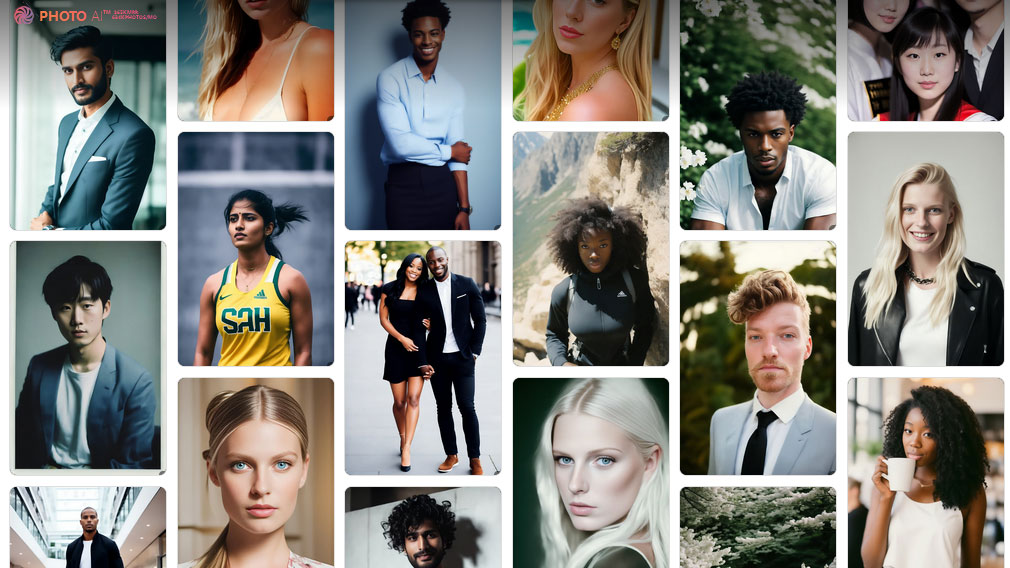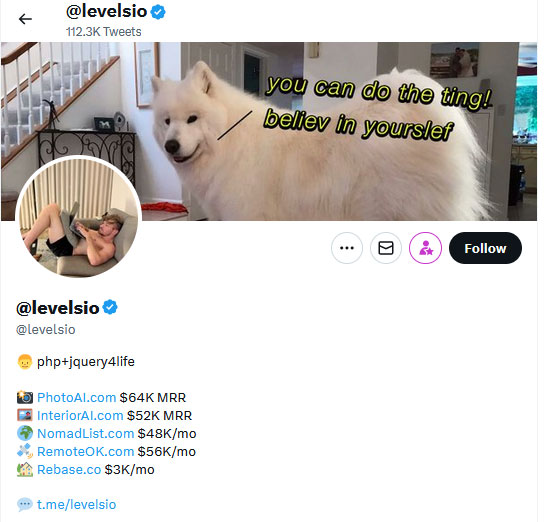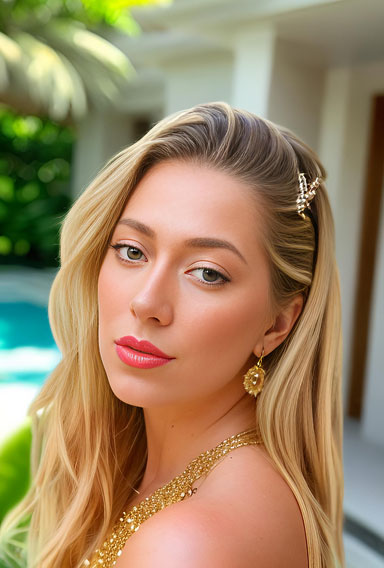A new AI portrait generator, Photo AI, momentarily garnered attention by sensationally claiming it can generate realistic portraits of living people, who can now ‘save money’ by avoiding an ‘expensive photographer’. (Gotta hate those expensive photographers!)

Photo AI launched its debut media campaign a month ago by making some bold claims:
‘Save money and use AI to do a photo shoot from your laptop or phone instead of hiring an expensive photographer. Create AI models (of yourself!) and do photo shoots in different poses, places and styles. Try on clothes you upload on your own AI model. Turn around time of just 14 seconds.’
An AI portrait where I can try on virtual clothes? Or place myself in any location in the world? Or contort my body into yoga poses that fitness influencers spend months mastering at an all-expenses-paid Byron Bay ashram?
All within 14 seconds? Where do I sign up!
‘The idea is that it costs less money and time to do photo shoots virtually than it does in real life (IRL),’ Photo AI’s FAQ states. ‘You save money in hiring and travelling the model and equipment and photo shoot team to a place.’
Although there is no proof to back up these declarations. Testimonials, reviews, online discussion – any credible third-party corroboration. Nothing yet exists.
And with AI image generators in their infancy, their limitations are plentiful when rendering the human body. They have a habit to produce anything but five-fingered hands; lifeless eyes and crooked mouths, plasticine smooth skin; and limbs vapourising into the ether. And this is work produced by the most powerful, publicly-available AI image generators like Dall E 2.
So when independent Dutch developer, Pieter Levels, unleashes a commercial AI portrait generator that will disrupt the professional portrait business, I’m naturally sceptical. But excited to learn more.
US$6.4 million stolen from photographers!
Levels’ Twitter bio brags about the monthly recurring revenue (MRR) generated by each of his ventures, and Photo AI is apparently the most successful, making US$64,000 each month. A major success! 
A cached April 2023 PhotoAI.com landing page boasted the ‘synthetic photo studio’ had garnered US$28,672 MRR in last 30 days. Is it a bit weird to publish private business information about revenue on the home page? I’ve never seen a professional photographer do this. Not even Peter Lik.
If we’re to believe Levels’ figures, then Photo AI’s monthly revenue translates roughly to 2200 customers paying US$29 per month for the cheapest ‘Pro’ package, which buys 1000 images. Or 214 customers paying US$299 per month for the Business Plan – 25,000 images.
‘If you do pay for a photographer yourself, it could cost you $250-1,500 per shoot which gives you 75-100 photos,’ Levels states in his press release. ‘With the Pro plan you get 1,000 photos per month, so about 10 regular photo shoots, which means $2,500 to $15,000 if it was a real photo shoot. So about 100x to 500x cheaper than booking a real photographer.’
Taking Levels’ figures at face value, then Photo AI is stealing more than US$6.4 million of revenue per month from portrait photographers. Photo AI seems to be a big threat. And not just to portrait photographers, but the whole industry that relies on professional photography – cameras, lenses, lighting, tripods, bags, studios, editing software, and workshops.
So Inside Imaging resolved to go that extra mile and review Photo AI. Be the guinea pig to find out if those dastardly portrait photographer rip-off merchants days are finally numbered.
A Photo AI review would be done with trepidation for a couple of reasons. Firstly, the concept of creating an AI model of myself makes me queasy, particularly if a model was later co-opted by ‘bad actors’; secondly, training the AI with 30 portraits – knowing it’s hyper analysing the pixels that structure my face – also makes me queasy.
But the guinea pig within rebukes this with a ‘who cares? You’re not special’. Meta probably listens in to private in-person conversations to send targetted ads, and ‘my data’ is likely harvested and traded regularly by tech giants, who in return provide me their services. It’s fair to assume my internet activities have, in some way, contributed to a few AI algorithms over the years. Why not do so willingly?
So we ‘reached out’ to Photo AI. And that’s pretty much where the story ends.
In an ideal world, Photo AI’s website contact form would lead to an e-mail exchange where I request permission to review the service. In response I receive a temporary log in, load my 30 portraits, generate AI models of myself, and write the review.
But there is no contact form. No active e-mail address. No way to privately contact anyone at Photo AI.
Although along the way an AI chat bot tried to sell me crypto investment tips.
Editor’s Note: A PR firm working for Levels confirmed that he has no affiliation with a crypto chat group, and this writer landed there by accident.

Why do we know about Photo AI?
Like most in the photography world, I became aware of Photo AI after reading Petapixel‘s coverage. I followed this up by a critical op-ed by Digital Camera World staff writer, Hannah Rooke, who received an e-mail from Photo AI.
‘Every word of this email made me angry. Photography is my livelihood, it’s my first and my second job, my passion, and someone is boasting about how their software can do what I do without the expense,’ she wrote. ‘There’s a reason you pay someone to take your photo – they know about lighting, they can bring the best out in you, they have expensive equipment they need to invest in and maintain and we (photographers) bring the best out in people by learning ways to make them feel relaxed.’
Photo AI is the first platform to assert that AI can perform the function of a photographer. But is it fair dinkum?
Photo AI’s landing page features the same text twice – the quote from the beginning of this article. It boasts as being ‘seen on’ TechCrunch, Fstoppers, Yahoo News, Petapixel, Fashion Network, Fast Company, Spotify, the MKHBD YouTube channel, and on TikTok and Instagram. (As in, someone posted about it on TikTok/Instagram?)
It’s an impressive list of publicity that lends a degree of credibility to this new AI portrait generator, and hence why this information appears front and centre on the home page.
Inside Imaging was unable to track down most of the coverage. Vigorous Google Searching only verified the Petapixel and Fashion Network articles. No content mentioning Photo AI or Pieter Levels can be found through searches on Fstoppers, TechCrunch, Fast Company or MKHBD. Interesting, no?
Photo AI’s FAQ explains that ‘you train yourself as an AI model and then take photos with it’. Or, to be precise, upload a wide-variety of 30 portraits to train the model, and then submit text prompts to generate images.
Levels does acknowledge the AI’s shortcomings, with three out of four photos ‘good enough’, and only one in 10 ‘exceptional’.
‘It’s not perfect though, the percentage of bad photos with AI is much higher than a regular photo shoot. But since it’s 100x cheaper that might not be such a problem.’
And if the pictures are consistently bad, it’s ‘100 percent’ a human error for not uploading a wide variety of portraits.
Contacting Levels
So the review. As mentioned, Photo AI has no contact form. I tracked down an e-mail address, legal@photoai.com, after finding it listed in the website’s Terms of Use and Privacy Policy. The e-mail bounced back, stating ‘all hosts for ‘photoai.com’ have been failing for a long time (and retry time not reached)’.
Levels asks Photo AI users to flag bugs and request features by ‘Tweeting them to me publicly’. An unorthodox business feedback and website troubleshooting method, but I suspect this is how Levels likes to operate. While the masses draft e-mails opening with the cliche ‘hope you’re well’, he’s shooting Tweets from the hip.
But I’m a Tweet virgin. I’ve gone more than 30 laps around the sun without ever penning a ‘Tweet’, and I intend to take this to my grave. Like many Australians, Twitter just isn’t for me. Nor is publicly requesting a review. This isn’t how we conduct business at Inside Imaging. I’m more of a ‘hope you’re well’ kind of guy.
Fortunately on Levels’ Twitter bio – below the enviable list of monthly revenue – is a Telegram channel. After clicking on what I thought was the link to join Levels’ Telegram chat room, I found myself in an odd back-and-forth with a ‘pro swing trader’ who spoke like an AI chat bot.
I have no idea how this eventuated but, as previously mentioned, a Levels’ PR firm states the entrepreneur has no affiliation with the group ‘you seem to have contacted in error’. Broken dialogue with an incompetent AI chat bot disguised as Levels felt like a fitting conclusion to this story. But I am inclined to believe the PR firm – it was likely a human error on my behalf. This embarrassing reality became more evident the second time I attempted to join Levels’ Telegram, where I gained access to a chat room where Levels shares his Tweets with 1231 subscribers.
If this whole experience serves as any indication, then portrait photographers can rest easy. For now.
– Will Shipton





Be First to Comment